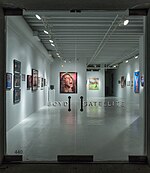St. Patrick's Church (New Orleans, Louisiana)
1833 establishments in Louisiana19th-century Roman Catholic church buildings in the United StatesChurches on the National Register of Historic Places in LouisianaGothic Revival church buildings in LouisianaHistory of New Orleans ... and 8 more
Irish-American culture in LouisianaNational Historic Landmarks in LouisianaNational Register of Historic Places in New OrleansRoman Catholic cathedrals in LouisianaRoman Catholic churches completed in 1840Roman Catholic churches in New OrleansUse American English from November 2019Use mdy dates from November 2019

St. Patrick's Church is a Catholic church and parish in the Archdiocese of New Orleans, Louisiana, United States. The parish was founded in 1833, and the current structure was completed in 1840. It is the second-oldest parish in New Orleans (the oldest parish is St. Louis Cathedral), located upriver from the French Quarter at 724 Camp Street in what is now the Central Business District. The building, a National Historic Landmark, is one of the nation's earliest and finest examples of Gothic Revival architecture.
Excerpt from the Wikipedia article St. Patrick's Church (New Orleans, Louisiana) (License: CC BY-SA 3.0, Authors, Images).St. Patrick's Church (New Orleans, Louisiana)
Camp Street, New Orleans Storyville
Geographical coordinates (GPS) Address Phone number Website Nearby Places Show on map
Geographical coordinates (GPS)
| Latitude | Longitude |
|---|---|
| N 29.946644444444 ° | E -90.069838888889 ° |
Address
Saint Patrick Catholic Church
Camp Street 724
70130 New Orleans, Storyville
Louisiana, United States
Open on Google Maps









